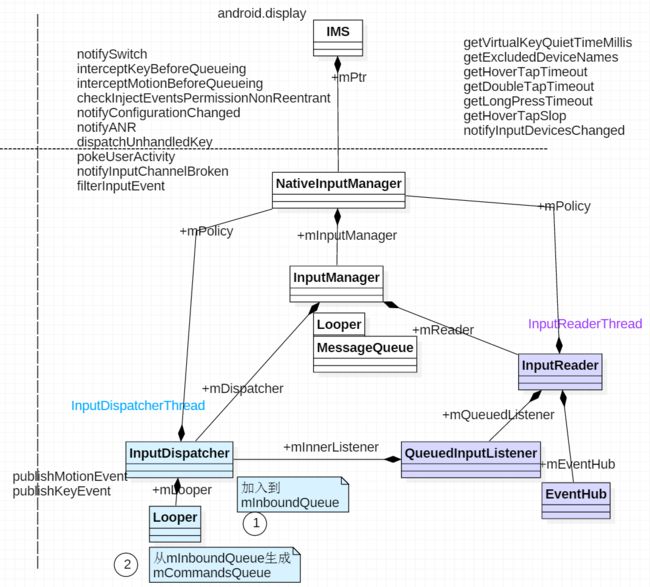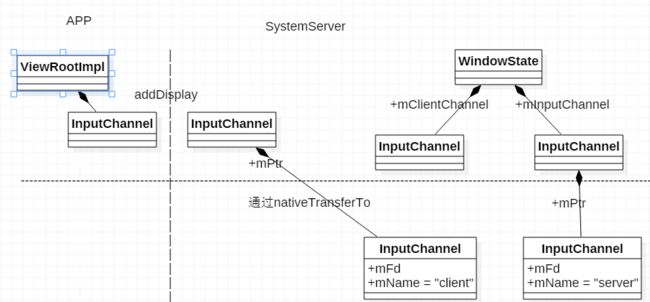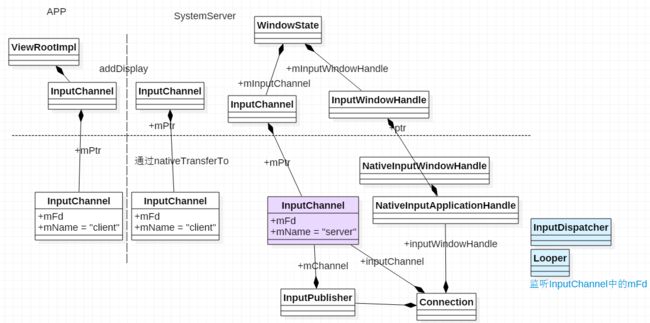https://www.jianshu.com/p/2bff4ecd86c9
本篇博客主要是过一下Android Input的框架,在熟悉Android input框架后,以及与App的事件传递流程后,再过一下事件的处理流程,以及ANR是怎样发生的。如果在不了解input的框架情况下就去直接按键等事件就会觉得很卡。
一、Android Input的工作模型
1.1InputDispatcher
InputDispatcher单独run在InputDispatcher线程中
1.1.1 InputDispatcher的模型
InputDispatcher的实现模型是Looper的机制,其底层根本还是属于epoll机制. 只不过Input并没有使用Looper相关的Message相关的功能,也就是说没有MessageQueue了,仅是单纯的使用Looper的addFd功能,以及它的epoll阻塞唤醒功能。
InputDispatcher单独运行在一个线程当中,当线程启动时,它会不停的调用threadLoop,
bool InputDispatcherThread::threadLoop() {
mDispatcher->dispatchOnce();
return true;
}
每一次threadLoop都会调用InputDispatcher的dispatchOnce函数
void InputDispatcher::dispatchOnce() {
nsecs_t nextWakeupTime = LONG_LONG_MAX;
{ // acquire lock
AutoMutex _l(mLock);
mDispatcherIsAliveCondition.broadcast();
// Run a dispatch loop if there are no pending commands.
// The dispatch loop might enqueue commands to run afterwards.
if (!haveCommandsLocked()) {
dispatchOnceInnerLocked(&nextWakeupTime);
}
// Run all pending commands if there are any.
// If any commands were run then force the next poll to wake up immediately.
if (runCommandsLockedInterruptible()) {
nextWakeupTime = LONG_LONG_MIN;
}
} // release lock
// Wait for callback or timeout or wake. (make sure we round up, not down)
nsecs_t currentTime = now();
int timeoutMillis = toMillisecondTimeoutDelay(currentTime, nextWakeupTime);
mLooper->pollOnce(timeoutMillis);
}
上面dispatchOnce先会尝试去获得pending的Commands,然后处理这些pending的命令。当这些都处理完成后,会调用Looper的pollOnce,传进去的参数是timeout. 正常情况下,如果当前没有唤醒,或没有fd的回调(这个后面会讲,也就是App消费了input事件的回调), 那么InputDispatcher线程就一直block在Looper的epoll那里,直到被唤醒。具体可以参考Android Handler/Looper
1.1.2 Looper的唤醒
1.1.1已经大致的说了下InputDispatcher线程的工作模型,没有事件时它会block在Looper的epoll处. 那它啥时候被唤醒呢?其实很简单,查找哪些地方调用了 mLooper->wake();,还有一个地方是App消费了input事件的回调(后面讲)
notifyConfigurationChanged()
notifyKey()
notifyMotion()
notifySwitch();
injectInputEvent()
setInputWindows()
setFocusedApplication()
setInputDispatchMode()
setInputFilterEnabled()
transferTouchFocus()
registerInputChannel()
unregisterInputChannel()
monitor()
上面这些函数都有调用到mLooper->wake的可能。
如notifyKey()/notifyMotion() 等, "间接"来自InputReader线程的通知。
setInputWindows()/setFocusedApplication()等,"间接"来自android.display线程的通知。
如果 App 消费了Input事件, Looper也会被唤醒,接着handleReceiveCallback被回调。
这里以notifyConfigurationChanged为例
void InputDispatcher::notifyConfigurationChanged(const NotifyConfigurationChangedArgs* args) {
bool needWake;
{ // acquire lock 防止多线程同时访问,这里加了一个mLock的互斥锁。
AutoMutex _l(mLock);
ConfigurationChangedEntry* newEntry = new ConfigurationChangedEntry(args->eventTime);
needWake = enqueueInboundEventLocked(newEntry);
} // release lock
if (needWake) {
mLooper->wake();
}
}
notifyConfigurationChanged其实挺简单的,生成一个ConfigurationChangedEntry,然后通过enqueueInboundEventLocked函数加入到mInboundQueue队列中。具体的可以看参考下enqueueInboudnEventLocked. 然后根据needWake决定是否唤醒Looper, 这个needWake,默认在mInboundQueue里没有数据时为true, 当mInboundQueue里有数据时,此时Looper应该已经被唤醒了,且正在处理mInboundQueue里的命令,此时已经是wake的状态,所以没有必要再次wake一次。
Queue mInboundQueue;
mInboundQueue申明为一个队列,主要是保存InputReader中传过来的EventEntry.
EventEntry主要有如下的几种类型
mPendingEvent是EventEntry类型,它根据type类型转为具体的EventEntry,如 MotionEntry, KeyEntry等等。
1.1.3 InputDispatcher处理Commands
从1.1的dispatchOnce()代码中可以看出,InputDispatcher在当前没有commands时会直接调用dispatchOnceInnerLocked一次,而dispatchOnceInnerLocked的目的就是去获得Commands.
如果当前有Commands了(比如1.2已经ConfigurationEventEntry),就不会去获得Commands,而是直接run已经有的Commands.
void InputDispatcher::dispatchOnceInnerLocked(nsecs_t* nextWakeupTime) {
if (! mPendingEvent) {
if (mInboundQueue.isEmpty()) {
if (!mPendingEvent) {
return;
}
} else {
mPendingEvent = mInboundQueue.dequeueAtHead();
}
...
} //这个if块意在获得一个mPendingEvent,如果没有Pending的event, 直接返回掉
//如果已经走到下面,mPendingEvent是不为空的,也就是有待处理的事件
switch (mPendingEvent->type) {
case EventEntry::TYPE_CONFIGURATION_CHANGED: {
done = dispatchConfigurationChangedLocked(currentTime, typedEntry);
break;
}
case EventEntry::TYPE_DEVICE_RESET: {
case EventEntry::TYPE_KEY: {
case EventEntry::TYPE_MOTION: {
}
这里依然以mPendingEntry为ConfigurationChangedEntry为例,
bool InputDispatcher::dispatchConfigurationChangedLocked(
nsecs_t currentTime, ConfigurationChangedEntry* entry) {
CommandEntry* commandEntry = postCommandLocked(
& InputDispatcher::doNotifyConfigurationChangedInterruptible);
commandEntry->eventTime = entry->eventTime;
return true;
}
InputDispatcher::CommandEntry* InputDispatcher::postCommandLocked(Command command) {
CommandEntry* commandEntry = new CommandEntry(command);
mCommandQueue.enqueueAtTail(commandEntry);
return commandEntry;
}
生成一个Commands,它的函数指针指向doNotifyConfigurationChangedInterruptible.
dispatchOnce在runCommandsLockedInterruptible()里去处理所有的Commands,这时会调用doNotifyConfigurationChangedInterruptible,
void InputDispatcher::doNotifyConfigurationChangedInterruptible(
CommandEntry* commandEntry) {
mLock.unlock();
mPolicy->notifyConfigurationChanged(commandEntry->eventTime);
mLock.lock();
}
最终调用mPolicy, 也就是NativeInputManager中的notifyConfigurationChanged, 将结果返回到java层去。
这种情况并没有包含 Key/Motion这样的事件情况,(后续会继续介绍)
1.1.4 小结
- a). InputDispatcher使用Looper的epoll模型, 意味着在没有命令处理时会block在epoll处
- b). 当IMS(java层) 或 InputReader有事件要dispatch时,它们会唤醒InputDispatcher
- c). InputDispatcher被唤醒后,会从mInboundQueue队列中查找pending的event, 然后生成对应的Commands, 最后执行这些Commands.
1.2 InputReader
InputReader单独运行在InputReaderThread中,它依然继承于Thread类,也就是当InputReaderThread线程运行起来后它会一直调用threadLoop()函数。InputReader并没有使用Looper机制,不过它使用到了EventHub里的 epoll 机制,和Looper的epoll机制一样。
1.2.1 EventHub
EventHub在NativeInputManager里初始化,并没有放到InputReader里初始化,其实完全可以放到InputReader里初始化的呢? why???
EventHub::EventHub(void) : ... {
acquire_wake_lock(PARTIAL_WAKE_LOCK, WAKE_LOCK_ID);
//创建一个epoll文件字柄
mEpollFd = epoll_create(EPOLL_SIZE_HINT);
mINotifyFd = inotify_init(); //创建一个inotify fd
//inotify 监听 /dev/input 目录
int result = inotify_add_watch(mINotifyFd, DEVICE_PATH, IN_DELETE | IN_CREATE);
...
//将inotify fd加入到epoll中
result = epoll_ctl(mEpollFd, EPOLL_CTL_ADD, mINotifyFd, &eventItem);
int wakeFds[2];
//创建一个管道
result = pipe(wakeFds);
mWakeReadPipeFd = wakeFds[0];
mWakeWritePipeFd = wakeFds[1];
...
result = epoll_ctl(mEpollFd, EPOLL_CTL_ADD, mWakeReadPipeFd, &eventItem);
}
从EventHub的初始化可以看出,它通过inotify监听 /dev/input里的文件的变化,另外创建了一个管道, 将read fd加入到epoll中去监听,而write fd主要用来唤醒epoll.
从 EventHub::wake()函数可以看出来
void EventHub::wake() {
ssize_t nWrite;
do {
nWrite = write(mWakeWritePipeFd, "W", 1);
} while (nWrite == -1 && errno == EINTR);
}
通过调用wake函数,往 write fd中写入一个字节,然后epoll监听的read fd就有事件发生,epoll就被唤醒了,这和Looper的wake机制一模一样。
1.2.2 InputReader初始化
InputReader::InputReader(const sp& eventHub,
const sp& policy,
const sp& listener) :
mContext(this), mEventHub(eventHub), mPolicy(policy),
mGlobalMetaState(0), mGeneration(1),
mDisableVirtualKeysTimeout(LLONG_MIN), mNextTimeout(LLONG_MAX),
mConfigurationChangesToRefresh(0) {
mQueuedListener = new QueuedInputListener(listener);
{ // acquire lock
AutoMutex _l(mLock);
refreshConfigurationLocked(0);
updateGlobalMetaStateLocked();
} // release lock
}
InputReader的构造函数中初始化了一个QueuedInputListener, 它接收InputListenerInterface作为它的参数,从InputReader调用可知,这个InputListenerInterface其实就是InputDispatcher, QueueInputListener只是作为InputDispatcher的Wrapper.
1.2.2.1 读取Java层中的配置
void InputReader::refreshConfigurationLocked(uint32_t changes) {
mPolicy->getReaderConfiguration(&mConfig);
mEventHub->setExcludedDevices(mConfig.excludedDeviceNames);
...
}
refreshConfigurationLocked的主要是通过getReaderConfiguration调用到Java层的配置信息,保存到mConfig里。具体调用到如下的接口
getVirtualKeyQuietTimeMillis
getExcludedDeviceNames
getHoverTapTimeout
getDoubleTapTimeout
getLongPressTimeout
getHoverTapSlop
这些函数具体实现就是去取一些framework-res.jar里的一些配置信息。读到的信息最后都会设置到InputReader里不同的模块中,比如"ecluded device name"会去设置 EventHub 里mExcludedDevices等等。
1.2.3 InputReader运作起来
bool InputReaderThread::threadLoop() {
mReader->loopOnce();
return true;
}
InputReaderThread线程开启后会不停的运行threadLoop函数, 而它会调用InputReader的loopOnce函数
void InputReader::loopOnce() {
... 太多细节就不多说了
//获得事件, 没有事件就block在EventHub中的epoll处
size_t count = mEventHub->getEvents(timeoutMillis, mEventBuffer, EVENT_BUFFER_SIZE);
{ // acquire lock
AutoMutex _l(mLock);
if (count) { //有事件了,着手处理事件
processEventsLocked(mEventBuffer, count);
}
...
} // release lock
// Send out a message that the describes the changed input devices.
if (inputDevicesChanged) {
mPolicy->notifyInputDevicesChanged(inputDevices);
}
//将获得的事件传给InputDispatcher去做处理
mQueuedListener->flush();
}
EventHub的getEvents函数太长,这里就不贴出来了, 它主要就是获得事件,这里的事件,并不单单指input事件,它还包括输入设备的add/remove等相关的事件.
获得输入设备加入和删除事件
输入设备的加入和移除事件跟几个变量非常相关.
- mNeedToReopenDevices
表示需要重新打开输入设备, 它会先close当前已经打开的设置做一些清理工作,具体参见closeAllDevicesLocked() 函数,将没有delete掉的设备用mClosingDevices来表示,最后会把 mNeedToScanDevices 置为true. - mClosingDevices
表示当前没有被delete掉的设备,这getEvents里就将这些设备依次删除掉, 并生成 DEVICE_REMOVED事件 - mNeedToScanDevices
该变量表示需要扫描输入设备,并打开输入设备,加入到mDevices中,用mOpeningDevices表示这些设备的Head - mOpeningDevices
表示刚刚打开的所有的设备,它是一个单链表的HEAD, getEvents会将它所保存的所有刚打开的设备创建一个DEVICE_ADDED事件 - mNeedToSendFinishedDeviceScan
表示finish 扫描输入设备, 会生成一个FINISHED_DEVICE_SCAN事件
getEvents通过将产生的事件放到mEventBuffer所指向的一维数给中,然后通过最后一个事件的地址-mEventBuffer地址就可以得到当前有多少事件,很巧妙。
获得输入设备的事件
输入设备加入后,如果没有具体的事件产生的话,它就会进入epoll的阻塞状态。
for (;;) {
//处理变化的事件
while (mPendingEventIndex < mPendingEventCount) {
const struct epoll_event& eventItem = mPendingEventItems[mPendingEventIndex++];
//针对EventHub::wake
if (eventItem.data.u32 == EPOLL_ID_WAKE) {
if (eventItem.events & EPOLLIN) {
awoken = true;
...
}
}
ssize_t deviceIndex = mDevices.indexOfKey(eventItem.data.u32);
Device* device = mDevices.valueAt(deviceIndex);
if (eventItem.events & EPOLLIN) {
int32_t readSize = read(device->fd, readBuffer,
sizeof(struct input_event) * capacity);
...
} else {
int32_t deviceId = device->id == mBuiltInKeyboardId ? 0 : device->id;
size_t count = size_t(readSize) / sizeof(struct input_event);
for (size_t i = 0; i < count; i++) {
struct input_event& iev = readBuffer[i]; //获得具体的输入事件
//将输入事件保存到mEventBuf中
event->deviceId = deviceId;
event->type = iev.type;
event->code = iev.code;
event->value = iev.value;
event += 1; //指向下一个事件
capacity -= 1;
}
//当有事件后就直接退出, awoken表示通过调用EventHub::wake函数唤醒epoll,也直接退出
if (event != buffer || awoken) {
break;
}
int pollResult = epoll_wait(mEpollFd, mPendingEventItems, EPOLL_MAX_EVENTS, timeoutMillis);
if (pollResult < 0) {
} else {
// Some events occurred.
mPendingEventCount = size_t(pollResult);
}
}
当有事件产生后,epoll_wait就会返回,将有改变的个数放到mPendingEventCount中, 再下一轮的for循环中, 就在while循环中处理变化的事件.
while循环其实挺简单,主要是通过从改变的输入设备中读取输入事件,然后保存到mEventBuf中,然后从getEvents返回。
处理事件
void InputReader::loopOnce() {
size_t count = mEventHub->getEvents(timeoutMillis, mEventBuffer, EVENT_BUFFER_SIZE);
if (count) {
processEventsLocked(mEventBuffer, count); // 处理事件
}
mQueuedListener->flush();
}
InputReader在有事件发生后,getEvents就会返回,如果返回的count > 0时,就着手处理这些事件
void InputReader::processEventsLocked(const RawEvent* rawEvents, size_t count) {
for (const RawEvent* rawEvent = rawEvents; count;) {
int32_t type = rawEvent->type;
size_t batchSize = 1;
if (type < EventHubInterface::FIRST_SYNTHETIC_EVENT) {
int32_t deviceId = rawEvent->deviceId;
while (batchSize < count) {
if (rawEvent[batchSize].type >= EventHubInterface::FIRST_SYNTHETIC_EVENT
|| rawEvent[batchSize].deviceId != deviceId) {
break;
}
batchSize += 1;
}
//处理输入事件
processEventsForDeviceLocked(deviceId, rawEvent, batchSize);
} else {
switch (rawEvent->type) {
case EventHubInterface::DEVICE_ADDED:
//输入设备加入
addDeviceLocked(rawEvent->when, rawEvent->deviceId);
break;
case EventHubInterface::DEVICE_REMOVED:
//输入设备移出
removeDeviceLocked(rawEvent->when, rawEvent->deviceId);
break;
case EventHubInterface::FINISHED_DEVICE_SCAN:
//configuration 改变
handleConfigurationChangedLocked(rawEvent->when);
break;
}
}
count -= batchSize;
rawEvent += batchSize;
}
}
processEventsLocked根据返回的那些事件依次处理,包括对输入设备的增加和移出,以及输入事件的处理。
这里依然以handleConfigurationChangedLocked为例
void InputReader::handleConfigurationChangedLocked(nsecs_t when) {
NotifyConfigurationChangedArgs args(when);
mQueuedListener->notifyConfigurationChanged(&args);
}
Vector mArgsQueue;
void QueuedInputListener::notifyConfigurationChanged(
const NotifyConfigurationChangedArgs* args) {
mArgsQueue.push(new NotifyConfigurationChangedArgs(*args));
}
handleConfigurationChangedLocked生成一个NotifyConfigurationChangedArgs然后通过QueuedListener,将NotifyConfigurationChangedArgs加入到mArgsQueue这个vector中
当InputReader::loopOnce()在处理完事件后会调用 mQueuedListener->flush();
void QueuedInputListener::flush() {
size_t count = mArgsQueue.size();
for (size_t i = 0; i < count; i++) {
NotifyArgs* args = mArgsQueue[i];
args->notify(mInnerListener);
delete args;
}
mArgsQueue.clear();
}
void NotifyConfigurationChangedArgs::notify(const sp& listener) const {
listener->notifyConfigurationChanged(this);
}
flush函数对mArgsQueue里所有的NotifyArgs,调用notify, 这里mInnerListener也就是InputDispatcher, 如NotifyConfigurationChangedArgs为例,调用InputDispatcher的notifyConfigurationChanged将事件传入到了InputDispatcher中了。
至此InputReader的工作模型就介绍完了。
1.3 Input java层与jni层相互调用
已经知道Input工作在三个线程中,一个java线程,两个jni线程(InputReader, InputDispatcher)
- Java通过jni获得相关信息
Java层通过各种 nativeXXX去获得jni中的相关信息,具体可以查询InputManagerService.java中的nativeXXX开头的函数, 如
nativeGetKeyCodeState()
nativeSetFocusedApplication()
它们对应的jni实现如下
static jint nativeGetSwitchState(JNIEnv* /* env */, jclass /* clazz */,
jlong ptr, jint deviceId, jint sourceMask, jint sw) {
NativeInputManager* im = reinterpret_cast(ptr);
return (jint) im->getInputManager()->getReader()->getSwitchState(
deviceId, uint32_t(sourceMask), sw);
}
static void nativeSetFocusedApplication(JNIEnv* env, jclass /* clazz */,
jlong ptr, jobject applicationHandleObj) {
NativeInputManager* im = reinterpret_cast(ptr);
im->setFocusedApplication(env, applicationHandleObj);
}
void NativeInputManager::setFocusedApplication(JNIEnv* env, jobject applicationHandleObj) {
sp applicationHandle =
android_server_InputApplicationHandle_getHandle(env, applicationHandleObj);
mInputManager->getDispatcher()->setFocusedApplication(applicationHandle);
}
如图,它们都是通过NativeInputManager去获得InputDispatcher或InputReader去做相应的处理,注意,这些都是在java线程中调用的,为了线程安全,在相应的实现中都有锁。
- Jni回调java接口
同样InputDispatcher和InputReader线程都有可能调用到java层的接口,具体就不多说了。
二、Android Input与App
第一节已经基本说了下Android Input的代码结构,input的作用就是获得输入设备产生的事件,并且分发出来,那分发到哪里去了呢? 当然是分发到了Focused的App里了。
if ((mWindowAttributes.inputFeatures
& WindowManager.LayoutParams.INPUT_FEATURE_NO_INPUT_CHANNEL) == 0) {
mInputChannel = new InputChannel(); //生成一个InputChannel
}
...
try {
...
res = mWindowSession.addToDisplay(mWindow, mSeq, mWindowAttributes,
getHostVisibility(), mDisplay.getDisplayId(),
mAttachInfo.mContentInsets, mAttachInfo.mStableInsets,
mAttachInfo.mOutsets, mInputChannel);
App在addView时,会在ViewRootImpl中生成InputChannel, InputChannel实现了Parcelable, 所以它可以通过Binder传输。具体是通过addDisplay()将当前window加入到WMS中管理,同时也会有相应的input的处理.
2.1 SystemServer端中WMS的addWindow
public int addWindow(Session session, IWindow client, ... InputChannel outInputChannel) {
final boolean openInputChannels = (outInputChannel != null
&& (attrs.inputFeatures & INPUT_FEATURE_NO_INPUT_CHANNEL) == 0);
if (openInputChannels) {
win.openInputChannel(outInputChannel);
}
}
addWindow会通过WindowState去openInputChannel()
void openInputChannel(InputChannel outInputChannel) {
String name = getName();
InputChannel[] inputChannels = InputChannel.openInputChannelPair(name);
mInputChannel = inputChannels[0];
mClientChannel = inputChannels[1];
mInputWindowHandle.inputChannel = inputChannels[0];
if (outInputChannel != null) {
mClientChannel.transferTo(outInputChannel);
mClientChannel.dispose();
mClientChannel = null;
} else {
}
mService.mInputManager.registerInputChannel(mInputChannel, mInputWindowHandle);
}
openInputChannel做了三件事,
一是通过openInputChannelPair也就是nativeOpenInputChannelPair去打开一组socket用于跨进程通信. 具体可以参考
android_view_InputChannel_nativeOpenInputChannelPair -> InputChannel::openInputChannelPair()
-
创建一对socket pair
transfer给outInputChannel
if (outInputChannel != null) {
mClientChannel.transferTo(outInputChannel);
mClientChannel.dispose();
mClientChannel = null;
- 注册InputChannel和InputWindowHandle给Input
mService.mInputManager.registerInputChannel(mInputChannel, mInputWindowHandle);
在registerInputChannel后, InputDispatcher就开始监听App在Server端的InputChannel了。
2.2 App端获得InputChannel
SystemServer端生成的InputChannel是在SystemServer进程中,App进程不能直接访问其地址,那App是怎么获得InputChannel的呢? 当然是通过Binder了.
App的ViewRootImpl在调用addToDisplay返回后,ViewRootImpl里的InputChannel就指向了正确的InputChannel, 它是Client端,即Client端的fd与SystemServer进程中Server端的fd组成 socket pair, 它们就可以双向通信了。 那App端的InputChannel是如何正确的Client的InputChannel呢?
在 IWindowSession类中
public int addToDisplay(... android.view.InputChannel outInputChannel) {
android.os.Parcel _data = android.os.Parcel.obtain();
android.os.Parcel _reply = android.os.Parcel.obtain();
...
mRemote.transact(Stub.TRANSACTION_addToDisplay, _data, _reply, 0);
...
if ((0 != _reply.readInt())) {
outInputChannel.readFromParcel(_reply);
}
}
Binder Proxy端(App)端中 ViewRootImpl中的InputChannel是从Parcel里读出来的。
public boolean onTransact(...) {
case TRANSACTION_addToDisplay: {
...
android.view.InputChannel _arg8;
_arg8 = new android.view.InputChannel();
int _result = this.addToDisplay(...);
reply.writeNoException();
reply.writeInt(_result);
...
if ((_arg8 != null)) {
reply.writeInt(1);
_arg8.writeToParcel(reply, android.os.Parcelable.PARCELABLE_WRITE_RETURN_VALUE);
} else {
reply.writeInt(0);
}
return true;
}
Binder Server端(SystemServer)在 onTransact里生成一个局部的InputChannel,在addDisplay处理完后,就将InputChannel序列化到Parcel中传递到App端.
static void android_view_InputChannel_nativeWriteToParcel(JNIEnv* env, jobject obj,
jobject parcelObj) {
Parcel* parcel = parcelForJavaObject(env, parcelObj);
if (parcel) {
NativeInputChannel* nativeInputChannel =
android_view_InputChannel_getNativeInputChannel(env, obj);
if (nativeInputChannel) {
sp inputChannel = nativeInputChannel->getInputChannel();
parcel->writeInt32(1);
parcel->writeString8(inputChannel->getName());
parcel->writeDupFileDescriptor(inputChannel->getFd());
} else {
parcel->writeInt32(0);
}
}
}
序列化的过程其实就三个,写name, 然后writeDupFileDescriptor, dup文件句柄。
反序列化过程
static void android_view_InputChannel_nativeReadFromParcel(JNIEnv* env, jobject obj,
jobject parcelObj) {
if (android_view_InputChannel_getNativeInputChannel(env, obj) != NULL) {
jniThrowException(env, "java/lang/IllegalStateException",
"This object already has a native input channel.");
return;
}
Parcel* parcel = parcelForJavaObject(env, parcelObj);
if (parcel) {
bool isInitialized = parcel->readInt32();
if (isInitialized) {
String8 name = parcel->readString8();
int rawFd = parcel->readFileDescriptor();
int dupFd = dup(rawFd);
if (dupFd < 0) {
return;
}
InputChannel* inputChannel = new InputChannel(name, dupFd);
NativeInputChannel* nativeInputChannel = new NativeInputChannel(inputChannel);
android_view_InputChannel_setNativeInputChannel(env, obj, nativeInputChannel);
}
}
}
反序化就是在 App端 native层生成一个InputChannel,然后dup 文件句柄,设置等等
2.3 App端注册InputChannel到Looper
通过 2.2 小节,App端已经获得了InputChannel,以及正确的socket fd. 那要怎么利用起来呢?
ViewRootImpl在addDisplay后,会生成一个WindowInputEventReceiver
if (mInputChannel != null) {
...
mInputEventReceiver = new WindowInputEventReceiver(mInputChannel,
Looper.myLooper());
}
Looper.myLooper()是App进程Main线程的Looper.
public InputEventReceiver(InputChannel inputChannel, Looper looper) {
mInputChannel = inputChannel;
mMessageQueue = looper.getQueue();
mReceiverPtr = nativeInit(new WeakReference(this),
inputChannel, mMessageQueue);
mCloseGuard.open("dispose");
}
WindowInputEventReceiver会调用父类InputEventReceiver构造函数,然后通过nativeInit函数将InputChannel的fd加入到Looper的epoll中去。
static jlong nativeInit(JNIEnv* env, jclass clazz, jobject receiverWeak,
jobject inputChannelObj, jobject messageQueueObj) {
sp inputChannel = android_view_InputChannel_getInputChannel(env,
inputChannelObj);
sp messageQueue = android_os_MessageQueue_getMessageQueue(env, messageQueueObj);
sp receiver = new NativeInputEventReceiver(env,
receiverWeak, inputChannel, messageQueue);
status_t status = receiver->initialize();
receiver->incStrong(gInputEventReceiverClassInfo.clazz); // retain a reference for the object
return reinterpret_cast(receiver.get());
}
status_t NativeInputEventReceiver::initialize() {
setFdEvents(ALOOPER_EVENT_INPUT);
return OK;
}
void NativeInputEventReceiver::setFdEvents(int events) {
if (mFdEvents != events) {
mFdEvents = events;
int fd = mInputConsumer.getChannel()->getFd();
if (events) {
mMessageQueue->getLooper()->addFd(fd, 0, events, this, NULL);
} else {
mMessageQueue->getLooper()->removeFd(fd);
}
}
}
也就是说在 App进程的Main线程的Looper中监听InputChannel的Client端。当有事件发生时,Looper就会回调 NativeInputEventReceiver::handleEvent()
2.4 小节
App通过Binder获得InputChannel的client端,然后将fd加入到App进程的Main线程中监听。
三、input事件的传递流程
3.1 Input事件传递Overview
在了解了input框架和App端与Input的关系后,input的按键等相关事件的传递过程就相当简单了。
图中绿色方块表示调用java的方法.
InputReader在将事件加入到mInboundQueue之前会尝试interceptKey, 如果按键被截获成功,那么在InputDispatcher的红色块会被drop掉
以及filterInputEvent. 如果filter成功,那在InputReader线程中就直接返回,不会再将Event传递到InputDispatcher中.
另外
一个InputDevice可支持多种Mapper, 取决于mClasses的值, 具体是在
InputDevice* InputReader::createDeviceLocked(int32_t deviceId, int32_t controllerNumber,
const InputDeviceIdentifier& identifier, uint32_t classes) {
InputDevice* device = new InputDevice(&mContext, deviceId, bumpGenerationLocked(),
controllerNumber, identifier, classes);
...
// Vibrator-like devices.
if (classes & INPUT_DEVICE_CLASS_VIBRATOR) {
device->addMapper(new VibratorInputMapper(device));
}
// Keyboard-like devices.
uint32_t keyboardSource = 0;
int32_t keyboardType = AINPUT_KEYBOARD_TYPE_NON_ALPHABETIC;
if (classes & INPUT_DEVICE_CLASS_KEYBOARD) {
keyboardSource |= AINPUT_SOURCE_KEYBOARD;
}
if (classes & INPUT_DEVICE_CLASS_ALPHAKEY) {
keyboardType = AINPUT_KEYBOARD_TYPE_ALPHABETIC;
}
if (classes & INPUT_DEVICE_CLASS_DPAD) {
keyboardSource |= AINPUT_SOURCE_DPAD;
}
if (classes & INPUT_DEVICE_CLASS_GAMEPAD) {
keyboardSource |= AINPUT_SOURCE_GAMEPAD;
}
if (keyboardSource != 0) {
device->addMapper(new KeyboardInputMapper(device, keyboardSource, keyboardType));
}
...
3.2 Native中Focused的App与Window
InputApplicationHandle表示的是一个Focused的Application
InputWindowHandle表示是当前系统中所有的Window, 当然这里是指可以接收Input事件的窗口, 它可以是多个,只不过只一个当前获得焦点的窗口。
3.1 设置Focused 的 InputApplicationHandle
当一个App resumed后,AMS就会调用setResumedActivityUncheckLocked去更新AMS的一些状态, 接着通知WMS去setFocusedApp
3.2 设置Focused 的 InputWindowHandle
void NativeInputManager::setInputWindows(JNIEnv* env, jobjectArray windowHandleObjArray) {
Vector > windowHandles; //保存所有从JAVA层传入的InputWindowHandle
if (windowHandleObjArray) {
jsize length = env->GetArrayLength(windowHandleObjArray);
for (jsize i = 0; i < length; i++) {
jobject windowHandleObj = env->GetObjectArrayElement(windowHandleObjArray, i);
//获得一个InputWindowHandle
sp windowHandle =
android_server_InputWindowHandle_getHandle(env, windowHandleObj);
if (windowHandle != NULL) {
//保存到windowHandles里
windowHandles.push(windowHandle);
}
}
}
mInputManager->getDispatcher()->setInputWindows(windowHandles);
void InputDispatcher::setInputWindows(const Vector >& inputWindowHandles) {
{ // acquire lock
AutoMutex _l(mLock);
//获得旧的所有的window的InputWindowHandle
Vector > oldWindowHandles = mWindowHandles;
mWindowHandles = inputWindowHandles; //保存所有InputWindowHandle
sp newFocusedWindowHandle;
bool foundHoveredWindow = false;
for (size_t i = 0; i < mWindowHandles.size(); i++) {
const sp& windowHandle = mWindowHandles.itemAt(i);
//updateInfo这里是去获得java层对应的InputWindowHandle的值, 并保存到InputWindowInfo里
//只有当InputWindowHandle里有InputChannel时,这个Window才可能接收 input事件
if (!windowHandle->updateInfo() || windowHandle->getInputChannel() == NULL) {
mWindowHandles.removeAt(i--);
continue;
}
//只有当InputWindowHandle hasFocus值为true时,此时将会改变focused InputWindowHandle
if (windowHandle->getInfo()->hasFocus) {
newFocusedWindowHandle = windowHandle;
}
}
if (mFocusedWindowHandle != newFocusedWindowHandle) {
if (mFocusedWindowHandle != NULL) {
// Focused InputWindowHandle改变了,此时会cancel掉上一个Focused的Window的事件
sp focusedInputChannel = mFocusedWindowHandle->getInputChannel();
if (focusedInputChannel != NULL) {
CancelationOptions options(CancelationOptions::CANCEL_NON_POINTER_EVENTS,
"focus left window");
synthesizeCancelationEventsForInputChannelLocked(
focusedInputChannel, options);
}
}
//指向最新的Focused InputWindowHandle
mFocusedWindowHandle = newFocusedWindowHandle;
}
//release没在mWindowsHandle里的旧的InputWindowHandle的信息
for (size_t i = 0; i < oldWindowHandles.size(); i++) {
const sp& oldWindowHandle = oldWindowHandles.itemAt(i);
if (!hasWindowHandleLocked(oldWindowHandle)) {
oldWindowHandle->releaseInfo();
}
}
} // release lock
// Wake up poll loop since it may need to make new input dispatching choices.
mLooper->wake();
}
从代码中可以看出,将java层中所有的InputWindowHandle都会加入到InputDispatcher里来保存,然后遍历所有的InputWindowHandle,根据其是否获得了焦点来将它设置为mFocusedWindowHandle
特别注意的是,InputWindowHandle里的InputWindowInfo的值都是通过获得Java层对应的InputWindowHandle的值。具体可以参见 NativeInputWindowHandle::updateInfo()
3.3 找到Focused的App与Window
由3.1, 3.2小节的知识,找到Focused的App与Window就非常简单了,为什么需要找到这两个呢?因为当前有输入事件,输入事件需要传递给当前获得焦点的App的窗口.
int32_t InputDispatcher::findFocusedWindowTargetsLocked(nsecs_t currentTime,
const EventEntry* entry, Vector& inputTargets, nsecs_t* nextWakeupTime) {
int32_t injectionResult;
String8 reason;
//当前Focused的App是否正在add window, 意思是还没有Focused的window
if (mFocusedWindowHandle == NULL) {
if (mFocusedApplicationHandle != NULL) {
injectionResult = handleTargetsNotReadyLocked(currentTime, entry,
mFocusedApplicationHandle, NULL, nextWakeupTime,
"Waiting because no window has focus but there is a "
"focused application that may eventually add a window "
"when it finishes starting up.");
goto Unresponsive;
}
//当前也没有Focused的 App
injectionResult = INPUT_EVENT_INJECTION_FAILED;
goto Failed;
}
// Check permissions. //检查是否具体INJECT_EVENT的权限
if (! checkInjectionPermission(mFocusedWindowHandle, entry->injectionState)) {
goto Failed;
}
// Check whether the window is ready for more input.
//进一步检查是否需要 drop
reason = checkWindowReadyForMoreInputLocked(currentTime,
mFocusedWindowHandle, entry, "focused");
if (!reason.isEmpty()) { //如果 reason不为空,就drop掉
injectionResult = handleTargetsNotReadyLocked(currentTime, entry,
mFocusedApplicationHandle, mFocusedWindowHandle, nextWakeupTime, reason.string());
goto Unresponsive;
}
// Success! Output targets.
injectionResult = INPUT_EVENT_INJECTION_SUCCEEDED;
//找到正确的InputChannel,加入到InputTargets中
addWindowTargetLocked(mFocusedWindowHandle,
InputTarget::FLAG_FOREGROUND | InputTarget::FLAG_DISPATCH_AS_IS, BitSet32(0),inputTargets);
// Done.
Failed:
Unresponsive:
...
return injectionResult;
}
经过findFocusedWindowTargetsLocked后就找到了正确的InputChannel, 然后通过socket通信就将事件传输到App端了。
3.4 ANR是怎么发生的?
可以看出ANR发生的源头是 handleTargetsNotReadyLocked. 从字面上来看应该是InputTargets还没有Ready,它主要是在3.3中的findFocusedWindowTargetsLocked中调用
情况一:mFocusedApplicationHandle != null, mFocusedWindowHandle== null
情况二:mFocusedApplicationHandle 与 mFocusedWindowHandle都不空的情况
- 当前Focused的window PAUSED了
- Focused的window的 Connection都没有,也就是还没有注册
- Focused的window的 Connection 不正常
- Focused的window的 Connection里塞满了输入事件, 还在等着App去finish掉事件
- 针对 KeyEvent情况,必须上一个事件完成了才行
- 针对Touch事件的情况
3.4.1 正常事件的流程
以 Key事件为例, Key事件按下是ACTION_DOWN, 抬起是ACTION_UP, 现在来看下这两个事件的正常流程如下.
-
先将事件加入到outBoundQueue,然后publishKeyEvent到App Main线程
-
然后立马将A事件从outboundQueue中剥离,加入到waitQueue中
-
App线程处理完按键事件了
App线程会调用nativeFinishInputEvent,进一步调用 sendFinishedSignal 向 SystemServer发送哪个按键事件已经被finish, 最后从waitQueue中移出掉事件
3.4.2 ANR发生
1. 假设 App 在处理 A事件(ACTION_DOWN), 没有返回。
2. 这时来了一个B事件(ACTION_UP).
这时findFocusedWindowTargetsLocked在checkWindowReadyForMoreInputLocked时发现waitQueue里不为空,这时就要调用handleTargetsNotReadyLocked了
reason = checkWindowReadyForMoreInputLocked(currentTime,
mFocusedWindowHandle, entry, "focused");
if (!reason.isEmpty()) {
injectionResult = handleTargetsNotReadyLocked(currentTime, entry,
mFocusedApplicationHandle, mFocusedWindowHandle, nextWakeupTime, reason.string());
goto Unresponsive;
}
int32_t InputDispatcher::handleTargetsNotReadyLocked(...) {
if (applicationHandle == NULL && windowHandle == NULL) {
//一般不会进入该分支,这个情况一般是系统刚启动或systemserver重启的情况
} else {
// mInputTargetWaitCause 默认情况下是INPUT_TARGET_WAIT_CAUSE_NONE
if (mInputTargetWaitCause != INPUT_TARGET_WAIT_CAUSE_APPLICATION_NOT_READY) {
nsecs_t timeout;
//获得超时时间,默认是5s
if (windowHandle != NULL) {
timeout = windowHandle->getDispatchingTimeout(DEFAULT_INPUT_DISPATCHING_TIMEOUT);
} else if (applicationHandle != NULL) {
timeout = applicationHandle->getDispatchingTimeout(
DEFAULT_INPUT_DISPATCHING_TIMEOUT);
} else {
timeout = DEFAULT_INPUT_DISPATCHING_TIMEOUT;
}
//设置cause为 APPLICATION_NOT_READY状态
mInputTargetWaitCause = INPUT_TARGET_WAIT_CAUSE_APPLICATION_NOT_READY;
mInputTargetWaitStartTime = currentTime;
//超时时间是dispatch这个事件的时间+5
mInputTargetWaitTimeoutTime = currentTime + timeout;
mInputTargetWaitTimeoutExpired = false;
//重新设置正确的mInputTargetWaitApplicationHandle
mInputTargetWaitApplicationHandle.clear();
if (windowHandle != NULL) {
mInputTargetWaitApplicationHandle = windowHandle->inputApplicationHandle;
}
if (mInputTargetWaitApplicationHandle == NULL && applicationHandle != NULL) {
mInputTargetWaitApplicationHandle = applicationHandle;
}
}
}
// 并不会进入,这里显示mInputTargetWaitTimeoutTime = current + 5s
if (currentTime >= mInputTargetWaitTimeoutTime) {
onANRLocked(currentTime, applicationHandle, windowHandle,
entry->eventTime, mInputTargetWaitStartTime, reason);
...
} else {
return INPUT_EVENT_INJECTION_PENDING;
}
}
这时候B事件就会设置正确的mInputTargetWaitCause, mInputTargetWaitApplicationHandle, mInputTargetWaitTimeoutTime.
如果隔了5s后,App Main线程还是没有返回,这时再来了一个C 事件,此时,在handleTargetsNotReadyLocked里就要发生ANR了
int32_t InputDispatcher::handleTargetsNotReadyLocked(...) {
if (applicationHandle == NULL && windowHandle == NULL) {
//一般不会进入该分支,这个情况一般是系统刚启动或systemserver重启的情况
} else {
// 此时的mInputTargetWaitCause 是INPUT_TARGET_WAIT_CAUSE_APPLICATION_NOT_READY
//不会进入该分支
if (mInputTargetWaitCause != INPUT_TARGET_WAIT_CAUSE_APPLICATION_NOT_READY) {
...
}
}
// 由于是隔了5s 左右,此时currentTime 就 大于 mInputTargetWaitTimeoutTime, 这时就要产生ANR了
if (currentTime >= mInputTargetWaitTimeoutTime) {
onANRLocked(currentTime, applicationHandle, windowHandle,
entry->eventTime, mInputTargetWaitStartTime, reason);
...
} else {
return INPUT_EVENT_INJECTION_PENDING;
}
}
3. 假设A事件(ACTION_DOWN)在5s内被consumed了, 那2中就不会发生ANR,那2中的B事件是何时在dispatch出去的呢?
void InputDispatcher::dispatchOnceInnerLocked(nsecs_t* nextWakeupTime) {
...
done = dispatchKeyLocked(currentTime, typedEntry, &dropReason, nextWakeupTime);
...
if (done) {
if (dropReason != DROP_REASON_NOT_DROPPED) {
dropInboundEventLocked(mPendingEvent, dropReason);
}
mLastDropReason = dropReason;
releasePendingEventLocked();
*nextWakeupTime = LONG_LONG_MIN; // force next poll to wake up immediately
}
}
bool InputDispatcher::dispatchKeyLocked(nsecs_t currentTime, KeyEntry* entry,
DropReason* dropReason, nsecs_t* nextWakeupTime) {
...
Vector inputTargets;
int32_t injectionResult = findFocusedWindowTargetsLocked(currentTime,
entry, inputTargets, nextWakeupTime);
if (injectionResult == INPUT_EVENT_INJECTION_PENDING) {
return false;
}
如果findFocusedWindowTargetsLocked返回为INPUT_EVENT_INJECTION_PENDING, 那dispatchKeyLocked就直接返回false, 在本例中,此处返回 false.
所以dispatchOnceInnerLocked并不会处理 if (done), 这就意思着不会调用releasePendingEventLocked,进而mPendingEvent也不会被置为NULL, 这样下一轮dispatchOnceInnerLocked中就会发现mPendingEvent不为NULL, 就继续dispatch上一次没有被dispatch出去的Event, 好巧妙。
四、小结
- Input工作于三个线程, android.display, InputReader, InputDispatcher线程
- Input与App的通信是通过socket.
- InputReader使用EventHub里的epoll机制, InputDispatcher使用Looper中的epoll机制
- App在consume掉input事件后,会通过nativeFinishInputEvent去通知Input移出到waitQueue里等待的事件,防止ANR.
- ANR的发生需要三个事件,第一个事件,让App线程处理,且 App线程不返回, 第二个事件开始计时,默认5s, 第三个事件在5s结束后来到,此时产生ANR





















